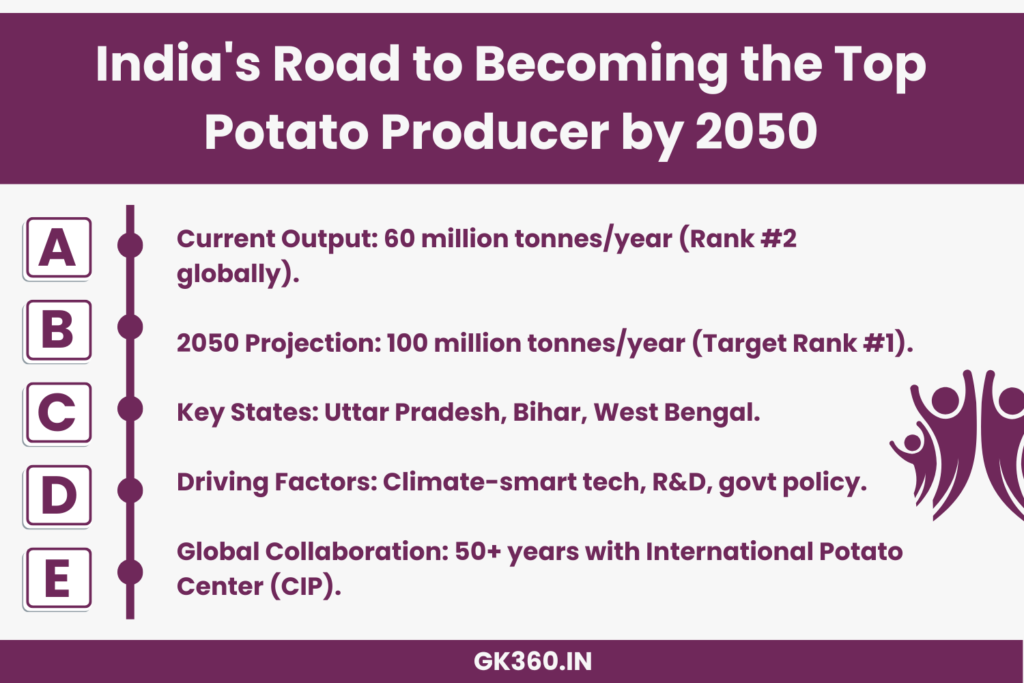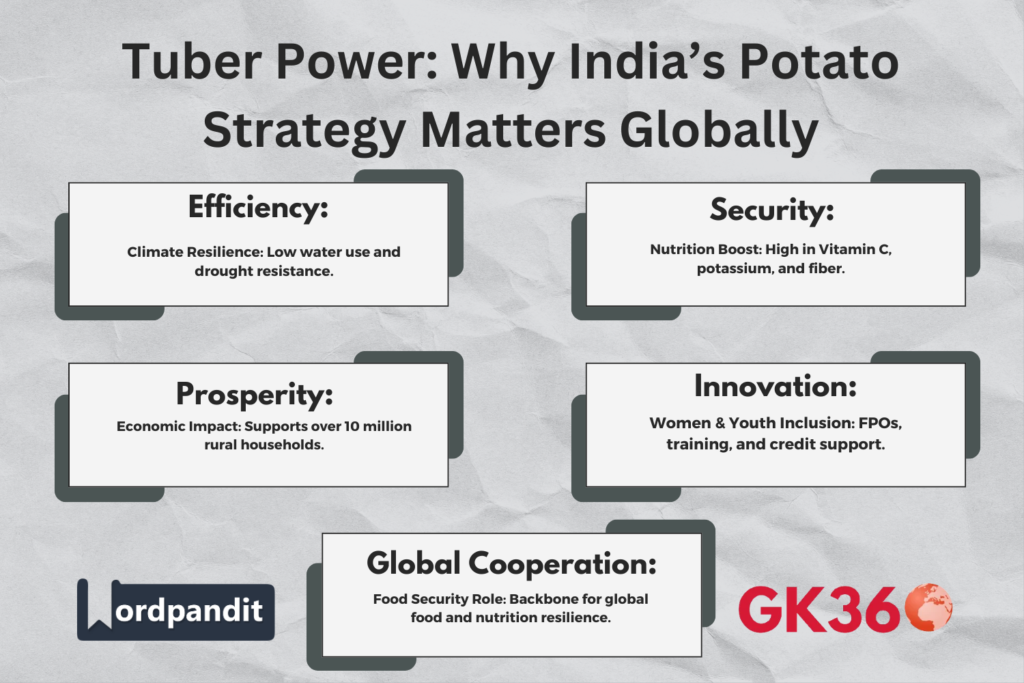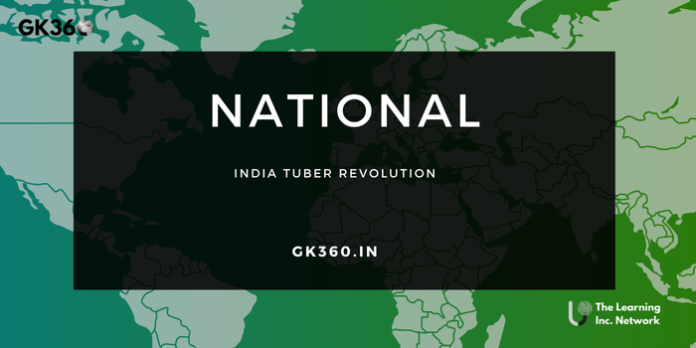India Tuber Revolution: On Track to Become World’s Top Potato Producer by 2050
India is rapidly advancing toward becoming the world’s leading potato-producing nation—a title currently held by China. With annual production expected to reach 100 million tonnes by 2050, experts and policymakers agree that India’s strategic shift in agricultural practices, climate-smart innovation, and policy support has the potential to transform not only the domestic landscape but also the global food economy.
At the heart of this transformation lies a unique blend of scientific collaboration, government vision, and the resilience of Indian farmers. Backed by partnerships like the International Potato Center (CIP) and a five-decade investment in tuber crop research, India is emerging as a global model for sustainable and inclusive agricultural growth.

Table of Contents
- India’s Growing Potato Ambitions
- Why the World Is Watching India’s Potato Growth
- Current Production vs. 2050 Projections
- India vs. China: The Potato Production Race
- Role of CIP and Global Collaborations
- Innovations in Climate-Smart Tuber Farming
- Government Initiatives Fueling the Growth
- Expert Insights on India’s Potato Strategy
- Empowering Women, Youth & Cooperatives
- Strategic Impact on Food and Income Security
- FAQs on India’s Potato Production Journey
- Conclusion: A Global Model for Sustainable Agriculture
India’s Growing Potato Ambitions
India’s agricultural vision has evolved significantly over the last two decades, with tuber crops like potatoes playing a central role in this shift. As the country aims to become a food-secure, self-reliant economy, the humble potato has emerged as a symbol of high-yield, climate-resilient farming.
Currently the second-largest potato producer globally, India accounts for nearly 60 million tonnes annually, supported by major potato belts in Uttar Pradesh, West Bengal, and Bihar. However, the target to hit 100 million tonnes by 2050 signals more than a numerical leap—it highlights India’s focus on nutrition, climate resilience, and inclusive growth through a single crop.
Why the World Is Watching India’s Potato Growth
India’s trajectory was spotlighted at a recent international symposium on Root and Tuber Crops in South Asia, where leading scientists, policymakers, and development partners applauded the nation’s efforts.
According to the International Potato Center (CIP), India’s roadmap positions it as a cornerstone of global food security. As climate uncertainty grows, so does the importance of crops like potatoes and sweet potatoes—both highly adaptable and nutrient-dense staples.
Key Takeaways from the Symposium:
- India is on track to surpass China in potato output by mid-century.
- Tuber crops are now recognized for their nutritional density and low water requirement, essential for climate-stricken regions.
- Experts emphasized inclusive farming models, particularly those empowering women and rural youth.
Current Production vs. 2050 Projections
Today:
- Annual Potato Production: ~60 million tonnes
- Global Rank: #2 (behind China)
By 2050 (Projected):
- Annual Potato Production: 100 million tonnes
- Expected Rank: #1 globally
This remarkable projected growth is being driven by:
- Agricultural R&D breakthroughs
- Wider adoption of climate-resilient seed varieties
- Access to high-yield farming practices
- Expansion of irrigation and cold storage infrastructure
India vs. China: The Potato Production Race
China currently holds the lead with annual yields exceeding 90 million tonnes. However, India is rapidly closing the gap, thanks to:
- Higher productivity per hectare in pilot regions.
- State-backed support for tuber-focused agricultural zones.
- Collaborative research with global institutions such as the CIP, which has deepened India’s technical capacity and field-level execution.
In the coming decades, India’s demographic advantage, combined with its large agricultural base, may tip the scale in its favor.
Role of CIP and Global Collaborations
A cornerstone of India’s success is its 50-year partnership with the International Potato Center (CIP). Based in Peru, CIP has played a transformative role by:
- Introducing high-yield, disease-resistant potato varieties.
- Supporting training programs for Indian agricultural scientists and farmers.
- Promoting innovations like aeroponic seed production and biofortification.
This collaboration has enabled India to scale potato farming across diverse climates, from the Indo-Gangetic plains to the hilly terrains of Himachal and Uttarakhand.
Innovations in Climate-Smart Tuber Farming
Potatoes and sweet potatoes are increasingly seen as climate-smart crops because:
- They require less water than cereals.
- They are quick-maturing and drought-resilient.
- They offer high energy and nutrient density (especially Vitamin C and potassium).
Focus Areas for Innovation:
- Precision farming tools (e.g., drip irrigation and satellite monitoring)
- Mobile-based agri-advisory for smallholder farmers
- Low-cost cold storage solutions for perishables
- Organic pest management to reduce input costs and environmental impact
Government Initiatives Fueling the Growth
The Indian government’s proactive agricultural agenda has accelerated potato production through:
- Subsidies for tuber seed distribution
- Training schemes under Krishi Vigyan Kendras (KVKs)
- Increased public-private partnerships for storage and supply chain development
- Enhanced agricultural budget allocations with a special focus on high-value, low-risk crops like potatoes
Agriculture Secretary Devesh Chaturvedi emphasized the integration of nutrition, innovation, and income support as part of a comprehensive tuber crop strategy.
Expert Insights on India’s Potato Strategy
At the international symposium on Root and Tuber Crops, global leaders and Indian policymakers shared their perspectives on the country’s tuber revolution.
Helen Hambly Odame – Chairperson, CIP Board
Helen praised India’s ambitious approach, noting its unique capacity to scale tuber crop innovation. She emphasized:
- Private-sector engagement in value chain development.
- The empowerment of women and youth as essential to long-term success.
- The potential for India to serve as a model for integrated tuber crop economies worldwide.
Devesh Chaturvedi – Agriculture Secretary, Government of India
Chaturvedi highlighted the critical role of resilient crop systems in India’s food and nutrition agenda. His key points included:
- Strengthening research for sweet potatoes and other tubers.
- Promoting farmer-researcher collaboration.
- Integrating crop innovation with rural livelihood strategies.
Ramesh Chand – Member, NITI Aayog
Chand framed agriculture as central to India’s economic engine. He remarked that tuber crop expansion:
- Supports poverty reduction in rural belts.
- Offers economic stability amidst climate change.
- Should be central to India’s agricultural export potential.
Empowering Women, Youth & Cooperatives
Tuber farming is increasingly being recognized as a platform for inclusive development. Key stakeholders are driving initiatives that:
- Integrate women and youth into agri-business and supply chains.
- Support entrepreneurship through FPOs (Farmer Producer Organizations).
- Facilitate access to credit and market linkages for small and marginal farmers.
Strategic Impact on Food and Income Security
India’s push for higher potato production intersects with several national priorities:
Rural Development
- Generates income for over 10 million farming households.
- Creates employment in processing, storage, and logistics.
Climate Resilience
- Tuber crops are low-risk compared to traditional cereals.
- Help mitigate food production volatility due to extreme weather.
Nutrition & Health
- Potatoes and sweet potatoes are rich in:
- Vitamin C
- Potassium
- Dietary fiber
- Offer an affordable solution to hidden hunger and malnutrition.

FAQs on India’s Potato Production Journey
- Why is India projected to surpass China in potato production by 2050?Due to sustained investments in R&D, climate-resilient farming, and government support, India is set to increase yield to 100 million tonnes.
- What role does the International Potato Center (CIP) play?CIP supports India with seed innovation, capacity building, and technology transfer, having partnered with Indian institutions for 50+ years.
- How do tuber crops support climate-smart agriculture?They require less water, are drought-resistant, and thrive across agro-climatic zones—making them ideal for changing weather patterns.
- What are the benefits for smallholder farmers?Farmers benefit from:
- Increased productivity
- Access to better seeds and markets
- Reduced risk in marginal lands
- How is India involving women and youth in this revolution?Through FPOs, government training, and start-up funding, women and youth are being engaged in value addition, logistics, and agri-tech ventures.
Conclusion: A Global Model for Sustainable Agriculture
India’s journey toward becoming the world’s leading potato producer by 2050 is not just a headline—it’s a symbol of how smart policy, innovation, and inclusive development can transform an entire sector.
With rising yields, enhanced farmer participation, and international cooperation, India’s tuber revolution is poised to:
- Strengthen food and nutrition security
- Enhance climate resilience
- Empower rural communities and agri-entrepreneurs
As the world seeks solutions to food insecurity and climate change, India’s potato strategy could serve as a blueprint for sustainable agriculture worldwide.
Key Takeaways Table
| Aspect | Details |
| Production Growth | From 60 million tonnes to projected 100 million tonnes by 2050. |
| Global Rank Shift | India aims to surpass China and become the world’s #1 potato producer. |
| R&D & Collaboration | 50-year partnership with CIP, innovations like aeroponics, disease-resistant seeds, and biofortification. |
| Climate-Smart Strategy | Emphasis on low water use, drought resistance, and precision farming tools. |
| Government Initiatives | Seed subsidies, Krishi Vigyan Kendras (KVKs), agri-budget expansion, and PPP in storage infrastructure. |
| Socioeconomic Empowerment | Women and youth engaged via FPOs, start-up funding, and skill-building. |
| Nutrition & Food Security | Potatoes as a solution to hidden hunger with high nutritional value and widespread adaptability. |





